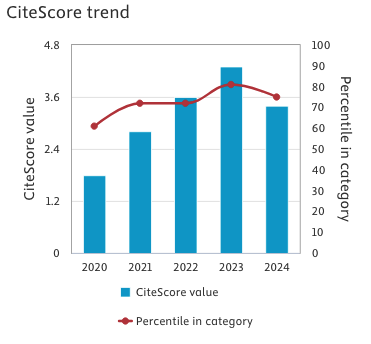Correlation of brain imaging scale, comorbidities, and cognitive decline
Keywords:
cognitive decline, comorbidities, fazekas, medial temporal lobe atrophy, montreal cognitive assessment-indonesian versionAbstract
Background and aim: Aging and increased life expectancy contribute to the rising prevalence of cognitive decline. Various diagnostic screening tools have been developed to assess cognitive function. While the impact of comorbidities on cognitive decline is well-established, further research is needed to understand their influence on diagnostic methods. This study explores the correlation between the MTA scale, Fazekas scale, and MoCA-INA, as well as the relationship between comorbidities and cognitive decline.
Methods: This cross-sectional study used MRI scans to assess the Fazekas scale and MTA scale, while the MoCA-INA test was administered by a certified neurologist. Statistical analyses, including Spearman and ANOVA tests, were conducted to evaluate correlations between the MTA scale, Fazekas scale, and MoCA-INA scores. Chi-square and Pearson tests were applied to examine the relationship between comorbidities and cognitive decline.
Results: The study sample included 18 males and 19 females. The MTA scale showed a significant negative correlation with cognitive decline (r = -0.513, p = 0.001). A combined analysis of MTA and Fazekas scale also yielded a significant negative correlation (r = -0.551, p = 0.002). Additionally, a significant correlation was found between stroke and small vessel disease with Fazekas scale (r = 0.342, p = 0.038).
Conclusions: The MTA is a reliable scale for assessing cognitive decline. The combination of the Fazekas and MTA scale have a significant effect with cognitive decline. Stroke and small vessel disease influenced the Fazekas scale significantly. Further research is needed to explore the combined impact of brain imaging scales and comorbidities in dementia.
References
Liu JK. Antiaging agents: safe interventions to slow aging and healthy life span extension. Nat Prod Bioprospect. 2022;12(1). doi: 10.1007/s13659-022-00339-y
Galvani-Townsend S, Martinez I, Pandey A. Is life expectancy higher in countries and territories with publicly funded health care? Global analysis of health care access and the social determinants of health. J Glob Health. 2022;12. doi: 10.7189/JOGH.12.04091
Ferreira RG, Brandão MP, Cardoso MF. An update of the profile of older adults with dementia in Europe: findings from SHARE. Aging Ment Health. 2020;24(3):374–81. doi: 10.1080/13607863.2018.1531385
Filler J, Georgakis MK, Dichgans M. Risk factors for cognitive impairment and dementia after stroke: a systematic review and meta-analysis. Lancet Healthy Longev. 2024;5(1):e31–44. doi: 10.1016/S2666-7568(23)00217-9
Veronese N, Koyanagi A, Dominguez LJ, et al. Multimorbidity increases the risk of dementia: a 15 year follow-up of the SHARE study. Age Ageing. 2023;52(4):1–8. doi: 10.1093/ageing/afad052
Biggs S, Carr A, Haapala I. Dementia as a source of social disadvantage and exclusion. Australas J Ageing. 2019;38(S2):26–33. doi: 10.1111/ajag.12654
Furtner J, Prayer D. Neuroimaging in dementia. Wiener Medizinische Wochenschrift. 2021;171(11–12):274–81. doi: 10.1007/s10354-021-00825-x
Rambe AS, Fitri FI. Correlation between the Montreal Cognitive Assessment-Indonesian Version (Moca-INA) and the Mini-Mental State Examination (MMSE) in Elderly. Open Access Maced J Med Sci. 2017;5(7):915–9. doi: 10.3889/oamjms.2017.202
Claus JJ, Staekenborg SS, Holl DC, et al. Practical use of visual medial temporal lobe atrophy cut-off scores in Alzheimer’s disease: Validation in a large memory clinic population. Eur Radiol. 2017;27(8):3147–55. doi: 10.1007/s00330-016-4726-3
Dautzenberg G, Lijmer J, Beekman A. Diagnostic accuracy of the Montreal Cognitive Assessment (MoCA) for cognitive screening in old age psychiatry: Determining cutoff scores in clinical practice. Avoiding spectrum bias caused by healthy controls. Int J Geriatr Psychiatry. 2020;35(3):261–9. doi: 10.1002/gps.5227
Park HY, Park CR, Suh CH, Shim WH, Kim SJ. Diagnostic performance of the medial temporal lobe atrophy scale in patients with Alzheimer’s disease: a systematic review and meta-analysis. Eur Radiol. 2021 Dec 1;31(12):9060–72. doi: 10.1007/s00330-021-08227-8
Care D, Suppl SS. 2. Diagnosis and Classification of Diabetes: Standards of Care in Diabetes—2024. Diabetes Care. 2024;47(January):S20–42. doi: 10.2337/dc24-S002
Wahlund LO, Westman E, van Westen D, et al. Imaging biomarkers of dementia: recommended visual rating scales with teaching cases. Insights Imaging. 2017;8(1):79–90. doi: 10.1007/s13244-016-0521-6
Fujita S, Mori S, Onda K, et al. Characterization of Brain Volume Changes in Aging Individuals With Normal Cognition Using Serial Magnetic Resonance Imaging. JAMA Netw Open. 2023;6(6):E2318153. doi: 10.1001/jamanetworkopen.2023.18153
Morrison C, Dadar M, Villeneuve S, Collins DL. White matter lesions may be an early marker for age-related cognitive decline. Neuroimage Clin. 2022;35(January):103096. doi: 10.1016/j.nicl.2022.103096
Jokinen H, Lipsanen J, Schmidt R, et al. Brain atrophy accelerates cognitive decline in cerebral small vessel disease The LADIS study. Neurology. 2012;78(22):1785–92. doi: 10.1212/WNL.0b013e3182583070
Li J, Zhao Y, Mao J. Association between the extent of white matter damage and early cognitive impairment following acute ischemic stroke. Exp Ther Med. 2017;13(3):909–12. doi: 10.3892/etm.2017.4035
Korf ESC, Van Straaten ECW, De Leeuw FE, et al. Diabetes mellitus, hypertension and medial temporal lobe atrophy: The LADIS study. Diabetic Medicine. 2007;24(2):166–71. doi: 10.1111/j.1464-5491.2007.02049.x
Susianti NA, Prodjohardjono A, Vidyanti AN, et al. The impact of medial temporal and parietal atrophy on cognitive function in dementia. Sci Rep. 2024;14(1):1–9. doi: 10.1038/s41598-024-56023-3
Farnsworth Von Cederwald B, Josefsson M, Wåhlin A, Nyberg L, Karalija N. Association of Cardiovascular Risk Trajectory With Cognitive Decline and Incident Dementia. Neurology. 2022;98(20):E2013–22. doi: 10.1212/WNL.0000000000200255
Zhou C, Guan XJ, Guo T, et al. Progressive brain atrophy in Parkinson’s disease patients who convert to mild cognitive impairment. CNS Neurosci Ther. 2020;26(1):117–25. doi: 10.1111/cns.13188
Hu Y, Cao C, Li M, He H, Luo L, Guo Y. Association between idiopathic normal pressure hydrocephalus and Alzheimer’s disease: a bidirectional Mendelian randomization study. Sci Rep. 2024;14(1):22744. doi: 10.1038/s41598-024-72559-w
Downloads
Published
Issue
Section
License
Copyright (c) 2025 Valentinus Besin , Farizky Martriano Humardani, Cindy Sadikin

This work is licensed under a Creative Commons Attribution-NonCommercial 4.0 International License.
This is an Open Access article distributed under the terms of the Creative Commons Attribution License (https://creativecommons.org/licenses/by-nc/4.0) which permits unrestricted use, distribution, and reproduction in any medium, provided the original work is properly cited.
Transfer of Copyright and Permission to Reproduce Parts of Published Papers.
Authors retain the copyright for their published work. No formal permission will be required to reproduce parts (tables or illustrations) of published papers, provided the source is quoted appropriately and reproduction has no commercial intent. Reproductions with commercial intent will require written permission and payment of royalties.






